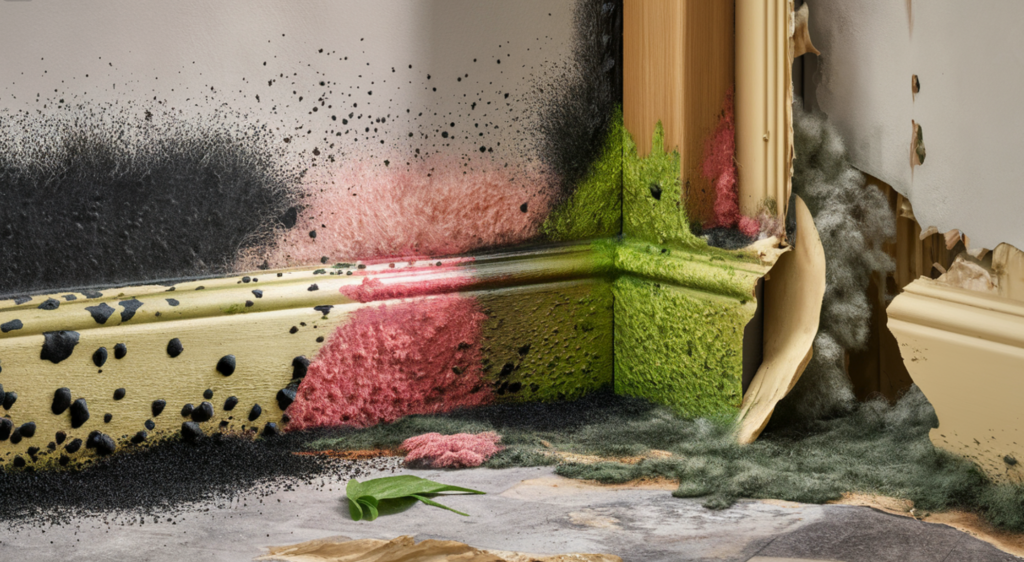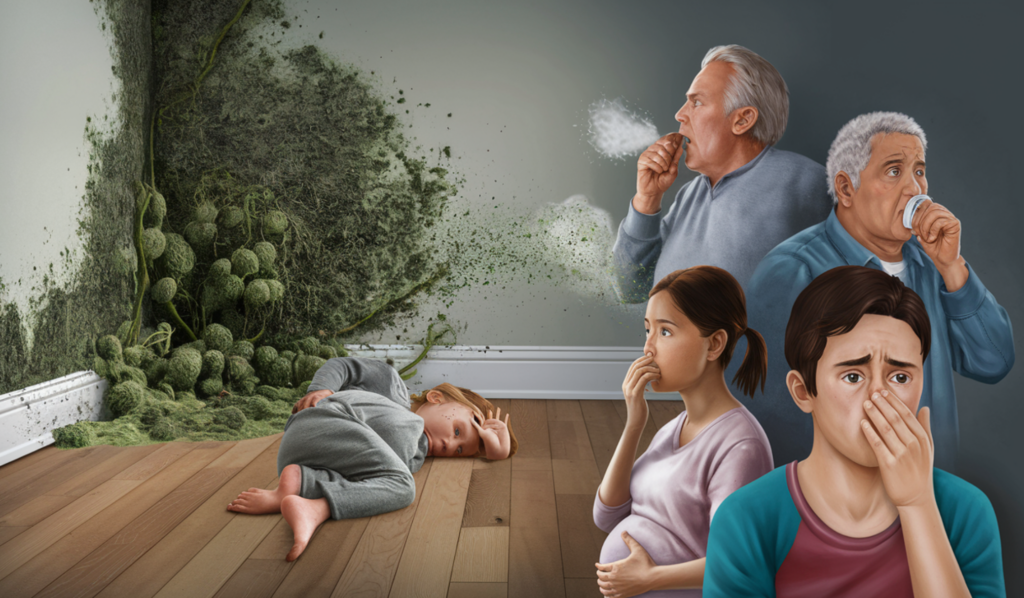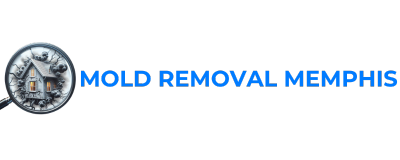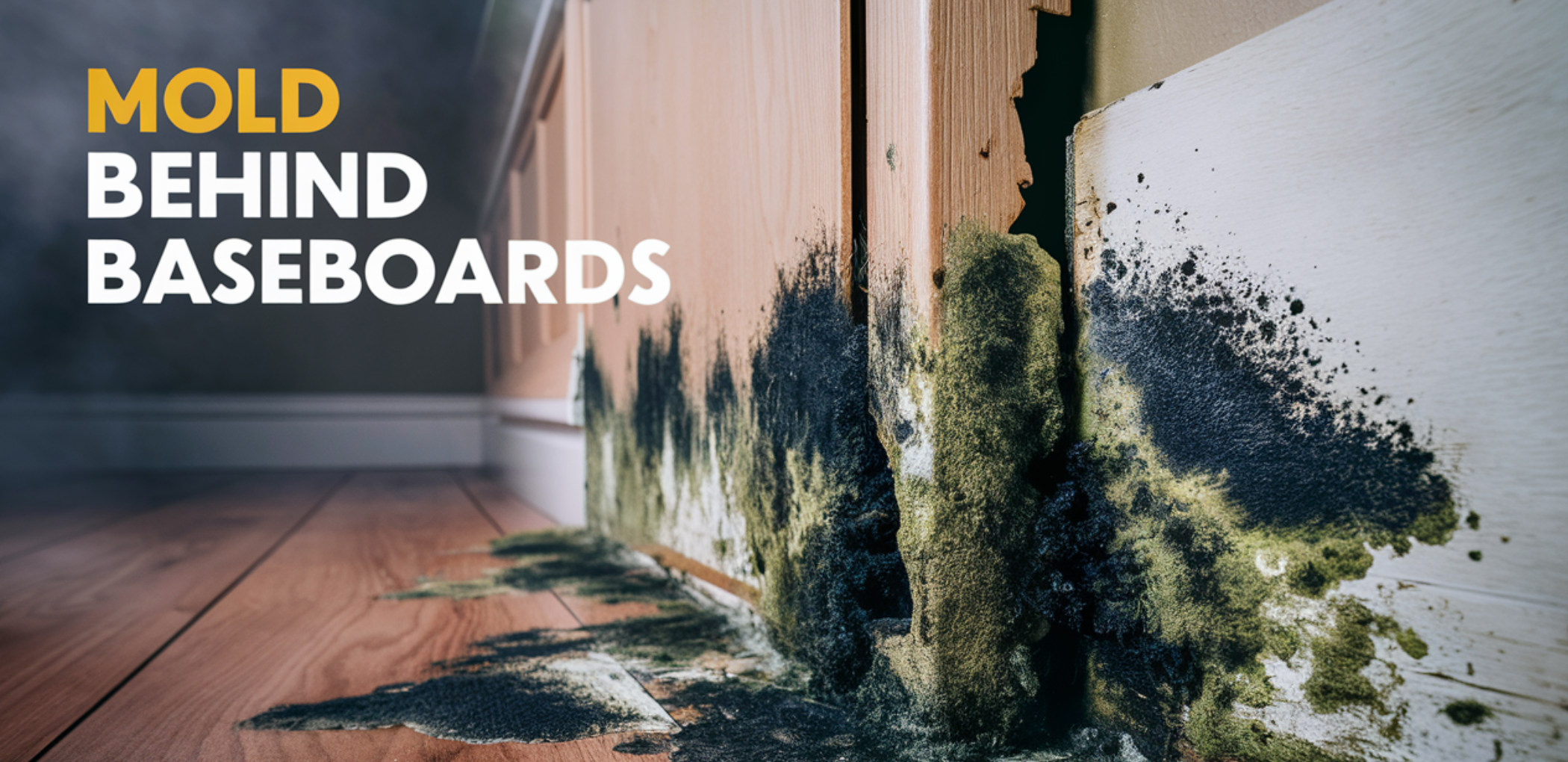Mold Behind Baseboards: Identify And Treat Black, Green And Brown Mold Issues
Mold growth behind baseboards is a common but often overlooked issue in homes. It can cause unpleasant odors and potential health concerns. Many homeowners are unsure how mold develops in these hidden areas and what steps to take for removal. This guide will explain the causes of mold behind baseboards and provide practical methods for addressing the problem. We’ll cover everything from identifying mold to effective cleanup techniques, helping you maintain a healthier living environment.
Mold behind baseboards, especially in bathrooms and near showers, often results from water leakage, poor drainage, or high humidity. Molds behind baseboards can develop within 48 hours of water exposure. Signs include discoloration, musty odors, and warped or squishy baseboards. Causes include plumbing leaks, improper sealing, condensation, or inadequate ventilation. To treat mold behind baseboards, first identify and fix the moisture source causing the mold. Carefully remove the affected baseboards to inspect for damage, and if necessary, cut out the drywall until you reach firm material. Clean visible mold using a bleach solution (1:10 ratio), vinegar, or specialized products like Concrobium. For extensive mold growth, replace any damaged materials with mold-resistant options like PVC baseboards and apply Kilz primer. Prevent mold recurrence by ensuring proper ventilation with high-efficiency exhaust fans, sealing gaps with 100% silicone caulk, and maintaining low humidity using dehumidifiers. In bathrooms, pay special attention to shower areas, replace worn caulking, and avoid using bath mats that trap moisture for extended periods. Always wear protective gear, such as an N95 mask, gloves, and goggles, when handling mold. For areas larger than 10 square feet or if unsure about the process, consult a professional mold remediation service.
What Does Mold On Baseboards Look Like?

Mold on baseboards typically appears as discoloration, often black, green, pink or fuzzy white in color. It can manifest as spotty patches or streaks along the length of the baseboard. The mold may look like a black dust accumulating in the small space between the baseboard and the floor, or it can present as a slimy or fuzzy texture on the surface of the baseboard. Mold growth on baseboards often starts in corners or areas where the baseboard meets the floor or wall. This is due to higher moisture accumulation in these regions.
In some cases, the mold growth may cause the paint on the baseboard to bubble, peel, or appear grimy. As the issue progresses, the baseboard may become warped, squishy, or show signs of water damage such as swelling or discoloration of the surrounding drywall. The mold can extend beyond the visible surface, potentially growing behind the baseboard and into the wall cavity.
| Visual Signs | Other Indicators |
|---|---|
| Discoloration (black, green, brown, white, gray, red) | Musty odor |
| Fuzzy or slimy appearance | High moisture meter readings (>15%) |
| Warping or swelling of material | Water stains |
| Peeling paint or wallpaper | Dampness in surrounding areas |
What Causes Mold To Grow Behind Baseboards?
Mold growth behind baseboards is primarily driven by the presence of moisture and organic material. Mold spores thrive in damp environments and feed on cellulose-based materials commonly found in baseboards.
Here are the factors contributing to mold growth behind baseboards:
1. Flooding
Floods from natural disasters, burst pipes, or overflowing appliances can saturate walls and baseboards. Any flooded area that was not completely dried within about one day is likely to have mold growth. Floodwaters can penetrate baseboards and the walls behind them, leading to mold proliferation if not promptly and thoroughly dried.
2. Water Leaks
Leaks from plumbing, roofs, or windows can cause water to seep into walls and baseboards, creating a moist environment favorable for mold. In case of roof leaks, water can seep down walls and accumulate at the base which leads to the mold growth.
3. High Humidity Levels
Mold growth is likely in areas where humidity levels are above about 70%. High humidity provides a continuous source of moisture that can be absorbed by baseboards and the materials behind them that fosters mold growth.
4. Condensation
Moisture can cause problems in homes, especially around baseboards. It starts when warm, damp air touches cooler surfaces and forms tiny water droplets. This happens more in places with poor airflow. Baseboards and nearby materials soak up this water, creating a perfect spot for mold to grow. You might see water on windows and walls, which can drip down behind baseboards. Poor insulation makes temperature differences bigger, leading to more moisture buildup.
Condensation cab also can be caused by a problem with a gas stove, heater, or dryer. You should have an inspection of fuel-burning appliances every year.
What Are The Health Risks Of Mold Behind Baseboards?

Mold growing behind baseboards can be a serious health concern. When mold grows in these hidden areas, it releases tiny spores into the air. Breathing in these spores can lead to various health problems.
People exposed to mold may experience cold-like symptoms, respiratory problems, nasal and sinus congestion, watery eyes, sore throat, coughing, and skin irritations.
For those with asthma, mold exposure can be particularly troublesome. It may trigger asthma attacks, making breathing even more difficult. The smallest mold spores are especially dangerous, as they can travel deep into the lungs when inhaled.
Living in a home with high levels of mold isn’t safe for anyone. However, certain groups face greater risks. These include young children, older adults, pregnant women, and people who already have breathing problems. For these individuals, the health effects of mold exposure can be more severe.
How To Get Rid Of Mold On Baseboards?
| Step | Action |
|---|---|
| 1. Protect Yourself | Wear PPE: respirator, eye protection, gloves, protective clothing |
| 2. Prepare the Area | Seal off work area, ensure ventilation |
| 3. Dampen Moldy Materials | Mist with water to reduce airborne spores |
| 4. Clean Surface Mold | Use cleaning solution, scrub, and rinse |
| 5. Remove Extensive Growth | Remove damaged materials, clean and sand if necessary |
| 6. Disinfect | Apply bleach solution and rinse |
| 7. Dry | Use fans, dehumidifiers, or natural ventilation |
| 8. Seal (optional) | Apply fungicide-containing product |
Here are steps to remove mold on baseboards:
1. Preparation And Safety Precautions
Before attempting to remove mold, take proper safety measures to protect yourself and prevent the spread of mold spores. Wear an N95 respirator mask or TC-21C particulate respirator, safety goggles or protective glasses, and waterproof rubber gloves. Wear long-sleeved clothing that can be immediately laundered or discarded after use.
Prepare the work area by sealing off the affected zone with plastic sheeting to prevent spore spread. Ensure proper ventilation by opening windows or using fans to exhaust air from the work area to the outside. Close doors and use plastic sheets to separate the room from unaffected areas. Before starting the removal process, mist moldy areas with water to minimize airborne spores.
We have detailed guide on mold mitigation process that walks you through each step in detail that is a part of mold removal process. You should check that as well. Moreover, we also provide mold remediation services. You can check our mold remediation cost calculator to get an estimate based on the conditions.
2. Mold Removal Process
Carefully remove the baseboard to inspect behind it. Check for mold growth on the drywall and studs, and determine if the damage is limited to the surface or has penetrated deeper.
For affected area of less than 10 square feet, you can try cleaning the surface mold.
Prepare a cleaning solution using one of the following options:
- 1 cup of vinegar in 1 gallon of water
- 1 cup of borax in 1 gallon of water
- Hydrogen peroxide (3% concentration)
- Non-ammonia soap or detergent in hot water
Apply the solution to the affected area using a spray bottle, then scrub the mold with a stiff brush, cleaning pad, or sponge. Wipe clean with a damp cloth and rinse the cleaned areas thoroughly with water.
For affected area of larger than 10 square feet, remove and dispose of heavily damaged baseboards. Cut out affected drywall at least 6 inches beyond visible mold growth. If carpet padding is affected, remove and discard it. Clean exposed studs and framing with a mold-killing solution. In cases where scrubbing doesn’t remove all mold residues from structural wood, sanding may be necessary.
4. Disinfecting The Area
To disinfect the moldy area around baseboard,
- For Clean Surfaces: Mix 1/4 cup to 1/2 cup of bleach per gallon of water.
- For Hard-to-Clean Surfaces: Mix up to 1 1/4 cups of bleach per gallon of water.
Here is how you can apply bleaching solution to the mold-affected baseboard area:
- Apply the bleach solution to the moldy area around the baseboard.
- Ensure the surface remains wet for about 15 minutes.
- Provide adequate ventilation during this process.
- Rinse the entire area with clean water.
5. Drying The Area
Use fans, dehumidifiers, or natural ventilation to dry the area rapidly. Ensure proper air circulation to prevent future moisture buildup. Materials that have been wet for more than 24 to 48 hours should be discarded if they look or smell moldy.
6. Sealing The Surface (optional)
As an optional final step, especially for wood beams, floor joists, and wood studs, contractors may seal the surface with a product containing a fungicide to encapsulate any remaining mold spores.
How To Treat Mold On Baseboard Near Shower Area In Bathroom?
To treat mold on baseboards in bathrooms, wear an N95 mask and clean with a dish soap, vinegar, and water mixture or 50% bleach solution (avoid on porous surfaces). For stubborn mold, use hydrogen peroxide and boric acid. Apply Kilz primer before repainting. Maintain 30-50% humidity with exhaust fans. Replace wood baseboards with PVC or tile. Use 100% silicone caulk in wet areas. Investigate leaks and remove affected drywall 6 inches above damage.
Remove Mold On Baseboard In Bathroom
- Remove the baseboard and inspect for water damage.
- Check for plumbing leaks or failed waterproofing.
- Replace damaged materials and reseal joints with 100% silicone caulk.
- Consider tiling instead of using wood baseboards.
How To Prevent Mold Growth Behind Baseboards?
To prevent mold from returning to your baseboards, you should follow these steps:
- Address Moisture Sources: Repair any water leaks promptly, including those from plumbing, roofs, or windows. Prevent water from seeping into walls and baseboards.
- Ensure Proper Ventilation: Ventilate areas prone to moisture, such as basements, bathrooms, and kitchens, to prevent condensation. Use exhaust fans and open windows to improve air circulation.
- Use Dehumidifiers: Maintain indoor humidity levels below 70 percent by using dehumidifiers, especially in damp areas. This helps reduce the overall moisture content in the air.
- Dry Wet Areas Quickly: Dry any areas that become wet within one day, particularly after flooding or water spills. Use fans, dehumidifiers, or natural ventilation to expedite the drying process.
- Seal Walls and Floors: Ensure that walls and floors are properly sealed to prevent moisture from seeping through. This is especially important for basements and other areas in contact with the ground.
- Maintain Cleanliness: Clean and dry areas under sinks, around washing machines, toilets, and faucets, as well as refrigerator and freezer drip pans and door gaskets, to eliminate potential mold breeding grounds.
- Ensure Proper Drainage: Ensure that water drains away from your house and does not collect under the slab or in crawl spaces. In homes with pier-and-beam foundations, ensure cross ventilation to keep the area dry and inspect for any plumbing leaks.
- Keep Gutters and Downspouts Clear: Ensure gutters and downspouts are clear and direct water away from your home to prevent moisture from seeping into the walls.
- Avoid Storing Items Against Walls: Avoid storing items directly against concrete walls and floors, as moisture can cause mold growth on or in these materials. Use shelves or pallets to elevate stored items.
- Use Mold-resistance Materials: Choose mold-resistant materials such as mold-resistant paint or primer for baseboards and walls. Consider PVC or composite baseboards in moisture-prone areas and install moisture-resistant drywall in bathrooms and basements.
When To Seek Professional Help For Mold Removal?
Consider professional mold remediation if:
- The affected area is larger than 10 square feet
- You suspect hidden mold growth within walls or under flooring
- You have underlying health conditions that may be exacerbated by mold exposure
- The mold is caused by contaminated water (e.g., sewage backup)
- You lack the necessary tools or expertise
- The mold growth is extensive or has penetrated deep into building materials
A professional mold remediation company can ensure thorough and safe mold removal, as well as address underlying moisture issues to prevent future growth. If you need mold inspection, air testing, or other environmental services in Memphis, contact the experts at +1 (901) 250-0431 today!

